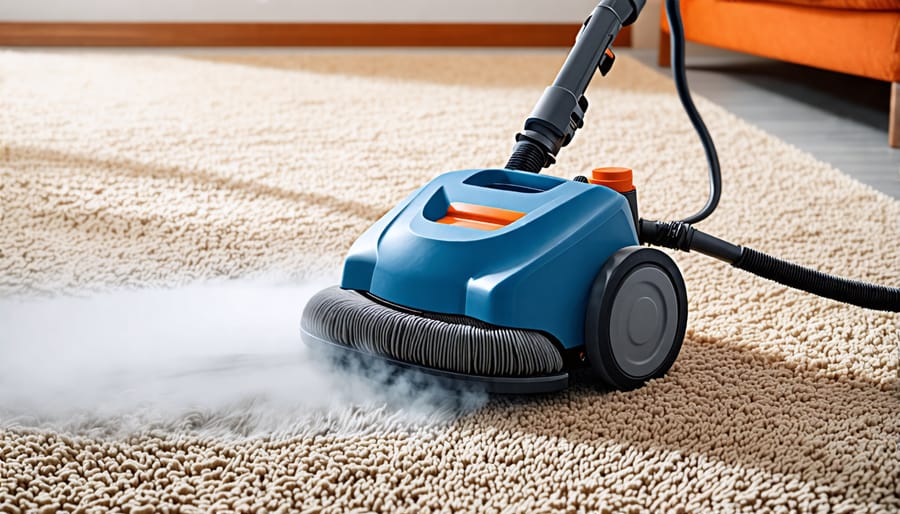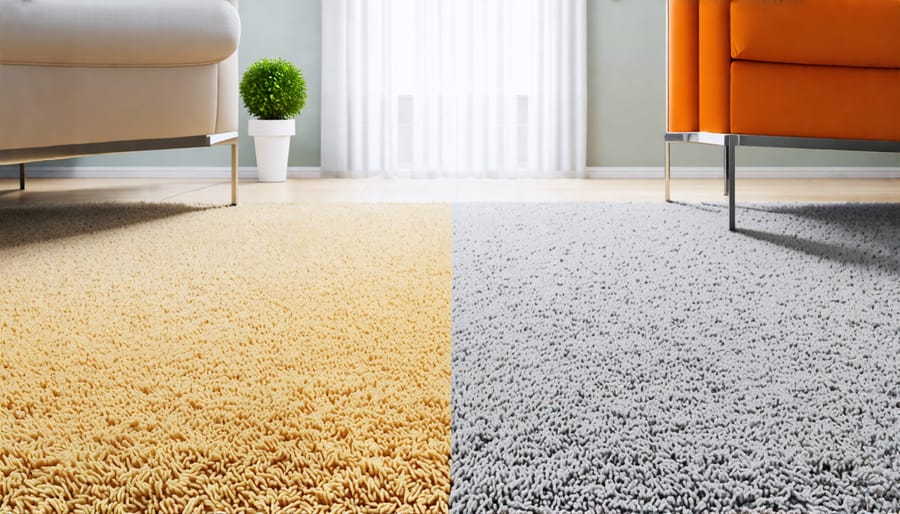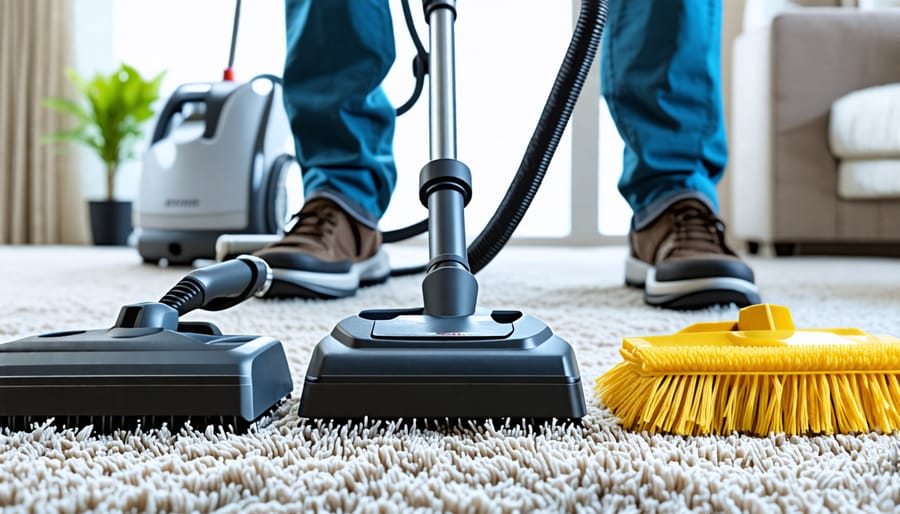Uncover the secrets of pristine carpets with these professional cleaning methods used by industry experts. Steam cleaning uses hot water extraction to deep clean fibers, while dry cleaning employs specialized compounds to lift dirt without moisture. Encapsulation captures soil in crystals for easy vacuuming, and bonnet cleaning scrubs the carpet surface for quick refreshes. Each technique offers unique advantages, from sanitizing to fast drying times, making them ideal for different carpet types and soil levels. By understanding these proven methods, you can choose the best approach to restore your carpets to their original beauty and extend their lifespan.

Hot Water Extraction (Steam Cleaning)
How It Works
Here’s how the hot water extraction process works:
First, the carpet is thoroughly vacuumed to remove loose dirt and debris. Next, a pre-conditioning solution is applied to the carpet fibers, which helps break down stubborn stains and ground-in soil. The solution is then agitated into the fibers using a brush or grooming tool.
After allowing the pre-conditioning solution to dwell for a few minutes, the hot water extraction process begins. A powerful machine injects hot water mixed with a cleaning solution deep into the carpet fibers at high pressure. Simultaneously, a powerful vacuum extracts the water, along with the dissolved dirt and grime.
The hot water effectively loosens and suspends the soil, while the strong suction removes the dirty water, leaving the carpet clean and fresh. The temperature of the water is typically between 180-220°F, which aids in sanitizing the carpet and killing bacteria and dust mites.
Finally, the carpet is groomed to restore the pile and enhance drying. High-velocity fans or air movers may be used to speed up the drying process, which typically takes between 4-6 hours. Once dry, the carpet is left clean, fresh, and rejuvenated.
Advantages and Disadvantages
Hot water extraction, also known as steam cleaning, is the most popular and thorough professional carpet cleaning method. One of its main advantages is its deep-cleaning ability. By injecting hot water and cleaning solution deep into the carpet fibers, it effectively removes embedded dirt, allergens, and stubborn stains. The high temperature also sanitizes the carpet, killing bacteria and dust mites.
However, hot water extraction has some drawbacks. The carpet requires a significant drying time of up to 24 hours, which can be inconvenient. There’s also a risk of over-wetting the carpet, leading to mold growth or damage to the carpet backing if not done properly. This is why it’s crucial to choose an experienced professional or follow proper techniques for Professional vs. DIY steam cleaning.
Another disadvantage is that the equipment can be quite loud, which may be disruptive in homes with young children or pets. The cost of professional hot water extraction can also be higher compared to other methods. Despite these drawbacks, hot water extraction remains the most effective way to deep-clean and refresh carpets, making it a top choice for many homeowners and professionals alike.
Encapsulation
The Encapsulation Process
The encapsulation carpet cleaning process involves applying a specialized cleaning solution that crystallizes dirt and debris, making it easy to vacuum away. This solution surrounds and encapsulates soil particles, breaking their bond with the carpet fibers. As the encapsulating solution dries, it hardens, effectively trapping the dirt in a brittle, crystallized form that can be easily sucked up by regular vacuuming.
One significant advantage of encapsulation is that it doesn’t require heavy saturation of the carpet, minimizing drying time. This makes it an excellent choice for high-traffic areas that need to be back in use quickly. The encapsulating solution also often contains a stain-resistant compound that coats the carpet fibers, helping to protect against future soiling and extending the time between deep cleanings.
While encapsulation is highly effective for maintaining carpets between more intensive cleanings, it may not be the best choice for heavily soiled or stained carpets. In such cases, hot water extraction or shampooing may be necessary to thoroughly clean the fibers. However, for routine maintenance and light to moderate soiling, encapsulation offers a convenient, efficient, and low-moisture solution that keeps your carpets looking their best.

Best Uses for Encapsulation
Encapsulation cleaning is ideal for lightly soiled carpets or as interim maintenance between deeper cleanings. This low-moisture method is perfect for high-traffic areas like entryways, hallways, and living rooms that need frequent attention. Since the carpet dries quickly, typically within an hour, it’s a convenient option for busy households and commercial spaces that can’t afford prolonged downtime. Encapsulation also helps maintain indoor air quality by reducing dust and allergens without leaving behind excess moisture that could lead to mold growth. For those looking to extend the life of their carpets with regular touch-ups, encapsulation offers an efficient and effective solution.
Bonnet Cleaning
The Bonnet Cleaning Technique
The bonnet cleaning method involves using a rotary floor machine fitted with an absorbent pad or “bonnet” to clean the top portion of carpet fibers. The cleaning solution is misted onto the carpet or applied to the bonnet, which is then rotated over the carpet surface at high speed. This spinning action helps lift dirt, dust, and light stains from the carpet fibers. While bonnet cleaning offers quick drying times and can freshen up carpets between deep cleanings, it is generally considered a surface-level cleaning method and may not effectively remove embedded dirt or heavy stains. This technique is best suited for lightly soiled, low-pile carpets or for quick touch-ups in high-traffic areas. However, be cautious when using bonnet cleaning on certain carpet types, such as Berber or high-pile carpets, as the spinning action may cause damage or excessive wear.
When to Use Bonnet Cleaning
Bonnet cleaning is ideal for lightly soiled carpets that require a quick refresh between deep cleanings. It’s also suitable for high-traffic areas that need frequent maintenance, such as hotel lobbies or office spaces. However, it’s not recommended for heavily soiled or stained carpets, as it may not effectively remove deep-seated dirt and grime. Additionally, bonnet cleaning should be avoided on carpets with loose fibers or those prone to shedding, as the spinning motion may cause further damage. For a more thorough and eco-friendly approach, consider using eco-friendly cleaning tips in conjunction with professional deep cleaning methods when necessary.
Dry Carpet Cleaning
How Dry Carpet Cleaning Works
Dry carpet cleaning, also known as compound cleaning, uses specialized powders or granules to absorb dirt and stains from carpet fibers. The process begins by thoroughly vacuuming the carpet to remove loose debris. Next, a cleaning compound is evenly distributed over the carpet, working it into the fibers using a motorized brush. This compound is typically made of biodegradable materials like cornstarch, which attract and absorb dirt, dust, and allergens.
After allowing the compound to sit for 15-30 minutes, a powerful vacuum is used to extract the powder along with the trapped dirt, leaving the carpet clean and dry. Some professional cleaners may use an encapsulation method, where a crystallizing cleaning solution surrounds dirt particles, making them easier to vacuum away.
Dry carpet cleaning offers several advantages, such as short drying times, making it convenient for busy households and commercial spaces. It’s also an eco-friendly option, as it uses minimal water and chemicals. However, for heavily soiled or stained carpets, dry cleaning may not be as effective as other methods. For routine maintenance and light soiling, though, dry carpet cleaning can be an efficient choice, especially when combined with automated cleaning solutions for daily upkeep.
Advantages and Disadvantages
The dry carpet cleaning method offers several advantages. It uses minimal moisture, so carpets dry quickly, often within 1-2 hours, minimizing disruption. The process is effective at removing surface dirt and debris. However, dry cleaning may not deep clean as thoroughly as other methods, and it can be less effective on heavily soiled or stained carpets. The carpet may also require more frequent cleaning to maintain appearance and hygiene compared to deep cleaning methods. Ultimately, dry carpet cleaning is a convenient option for busy households or lightly soiled carpets, but it may not be the best choice for deep stains or ground-in dirt.
Choosing the Right Method
When selecting a professional carpet cleaning method, consider factors like the type of carpet fibers, level of soiling, and any specific concerns such as allergies or pet stains. Hot water extraction is often the go-to choice for deep cleaning heavily soiled carpets, while dry compound cleaning may be preferable for delicate natural fibers or when quick drying is essential. Bonnet cleaning can effectively maintain lightly soiled, low-pile carpets between more thorough cleanings. For spot treatments or interim touch-ups, encapsulation cleaning offers a convenient solution. Assess your carpet’s unique needs and consult with a professional to determine the most suitable approach. Our guide on choosing the best carpet cleaning method provides further insights to help you make an informed decision. By selecting the right method for your carpet, you can ensure optimal results, extend its lifespan, and maintain a clean, healthy home environment.

Conclusion
In conclusion, professional carpet cleaning is essential for maintaining the appearance, health, and longevity of your carpets. By understanding the different methods available, you can make an informed decision on which approach best suits your needs. Whether you opt for hot water extraction, dry cleaning, bonnet cleaning, or shampooing, regular professional cleaning removes deep-seated dirt, allergens, and stains that everyday vacuuming cannot tackle. Investing in professional carpet cleaning not only enhances the aesthetic appeal of your home but also contributes to a healthier living environment for you and your family. Remember, clean carpets are the foundation of a well-maintained and inviting home.





